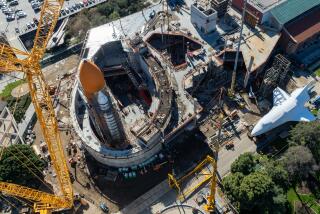Astronauts’ Pit Stop at 370 Miles Up
- Share via
HOUSTON — As sleepless astronomers held their breath, two astronauts began an exacting orbital house call on the $2-billion Hubble Space Telescope late Thursday, culminating two years of painstaking rehearsals for one of the most demanding tasks in NASA’s space program.
In a six-hour spacewalk scheduled to end early today, the astronauts planned to replace two outdated instruments in the bus-sized orbital telescope with more sophisticated sensors designed to dramatically improve its color vision and expand its ability to perceive infrared light.
“Hubble was built to be serviced, and this is a bit more exotic than getting a part replaced on your car, but it’s similar in some respects because this is all part of routine maintenance,” NASA spokesman Steve Nesbitt said.
The spacewalk by payload commander Mark Lee and mission specialist Steven Smith was temporarily delayed when Hubble’s right solar panel suddenly moved, apparently when air from the air lock hit it. But there was no apparent damage and the walk began only 15 minutes late.
“Oh my gosh. Beautiful!” Lee said as he gazed at the 43-foot telescope.
Nesbitt said the astronauts should be able to finish all the work they had planned for today.
The crew of the space shuttle Discovery, parked in orbit 370 miles above Earth, will conduct three more midnight spacewalks over the weekend to complete a $350-million refurbishment of NASA’s orbital eye, replacing vintage 1970s technology with the best the 1990s has to offer.
The new equipment will let astronomers stare with clearer, more discerning eyes at a universe of wonders, from the dense dust clouds in which stars and planets are born to the voracious black holes devouring the hearts of many galaxies. “We’re salivating,” said one University of Michigan stargazer.
Later today, astronauts Gregory J. Harbaugh and Joseph R. Tanner plan to replace a failing guidance sensor with an $8-million device designed to ensure that the telescope can stay aimed properly.
First they must install handrails and foot rails to protect the instrument as they work. After wiggling the new guidance sensor into place, they must undo six bolts and 18 delicate electrical connectors, with fingers made stiff and clumsy by space gloves, to replace an engineering data recorder.
Drawing from a collection of 150 tools and crew aids especially designed for the mission, the crew will ratchet into place a variety of other upgrades Saturday and Sunday, including protective lens caps and a grab bag of new electronics. The shuttle also will nudge the observatory into a slightly higher orbit to extend its lifetime.
It is the second time in three years that NASA has launched a service mission to the Hubble. Two more servicing missions are planned to keep the telescope operational well into the next century.
In 1993, astronauts snagged the telescope with the shuttle’s robot arm and, in a series of dramatic midnight spacewalks, hauled it aboard the shuttle to repair its out-of-focus optics, which had been seriously flawed in the manufacturing process.
When astronaut Steve Hawley, who helped launch Hubble in 1990, captured the gleaming 12-ton observatory and maneuvered it into the cargo bay early Thursday, the telescope seemed none the worse for its years in space, although the NASA logo on its side was peeling and there appeared to be a small hole, caused by a micrometeorite, in one of its large solar wings.
“I wish you could see the expression on Dr. Stevie’s face,” shuttle commander Kenneth Bowersox radioed mission control. “Looks like he just shook hands with an old friend.”
Barring complications, Lee and Smith were expected to work in the cargo bay until early today removing the Goddard High Resolution Spectrograph and replacing it with the $125-million Space Telescope Imaging Spectrograph.
The state-of-the-art spectrograph will be able to gather 30 times more data about the composition, temperature and chemical properties of astronomical objects and 500 times more spatial data, NASA engineers said.
The astronauts also are to swap the Faint Object Spectrograph for the more sophisticated, $105-million Near Infrared Camera and Multi-Object Spectrometer. Its cluster of three cameras will offer Hubble its first infrared view of the universe.
Hotz reported from Los Angeles. Times researcher Lianne Hart in Houston also contributed to this story.
(BEGIN TEXT OF INFOBOX / INFOGRAPHIC)
THE SERVICE CALL
1) Install a new, $125-million spectrograph that can analyze more color from deep space.
2) Put in a near-infrared camera that expands viewing distance and sees through dust clouds.
****
HOW HUBBLE WORKS
A) Light enters telescope and bounces off mirrors. B) Then it shines on science instruments C) through a hole in the center of the primary mirror.
More to Read
Sign up for Essential California
The most important California stories and recommendations in your inbox every morning.
You may occasionally receive promotional content from the Los Angeles Times.













